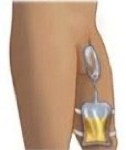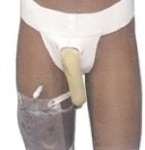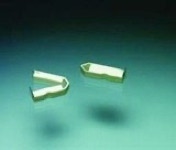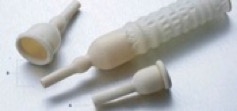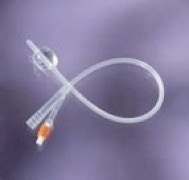OTHER DEVICES USED TO MANAGE INCONTINENCE
There are many other devices and methods for dealing with urinary and/or bowel incontinence. This page will deal specifically with ways of managing urinary incontinence. Diapers are NOT the only solution or method for managing incontinence for the most part. While men have the “luxury” of penile clamps and condom catheters or male urinals, females are not as “lucky”. as their primary urinary incontinence management measures are either foley catheter, intermittent catheter, pads or diapers. So, without further adieu, here are the products available.
The Penile Clamp
This picture is of the Cunningham Male Penis Clamp. This clamp does exactly what it looks like. It closes around the penis gently squeezing the urethra so that no urine dribbles out. This device should be carefully fitted and prescribed by an Urologist as it can cause serious damage to the urethra and tissues if not fitted properly. Generally this product is for the male who just dribbles continuously. This product is usually not recommended for males who have high tone or spastic bladders (bladders that contract continually) as the pressure that builds inside the bladder can force urine back up into the kidneys causing kidney damage.
Condom Catheters
This picture shows what a condom/external catheter looks like. As the name implies, this catheter rolls onto the penis just like an ordinary catheter and connects to tubing which runs down to a leg bag for collection of urine. Many men prefer this option due to mobility reasons (easier to empty a leg bag than to change a diaper if you are in a wheelchair) or because they prefer the option to wearing a diaper. The benefits are that nothing is inserted into the penis, the skin is kept dry, easier to manage for someone with limited dexterity, and generally more “acceptable” or “dignified” than diapers. The drawbacks are that the device sticks directly to the skin, which can irritate the skin and cause problems. Infection can be a risk as well. The condom can “pop off” which is exactly what it sounds like and urine ends up on the clothes, etc... or the leg bag can leak. Many men say that with proper fitting and management that this is a very viable management tool. This device should be PROPERLY fitted on the advice of a professional. If the condom is too tight, it can cut off circulation to the penis, but if it is too loose, it will leak and/or come off.
This picture shows how a condom catheter fits over the penis and attaches to a leg bag on the thigh by a drainage tube. This setup is concealed by your everyday clothing and pretty much undetectable. A man can even wear underwear as usual.
The McGuire Male Urinal
This device is known as the McGuire Urinal. This device functions just like the condom catheter above. The main differences are that the device is supported with an underwear like garment (as you can see in the picture) and the urinal does not attach to the penis at all. Your penis is inserted into the urinal and it is like a sleeve. This is beneficial in that no glue comes in contact with the skin and the penis is not constricted or squeezed like with a condom. The drawback can be that urine flows back inside the urinal while sitting and leaks out the top of the urinal. As you can see, the urinal is attached to a bag that straps to the thigh like with the condom catheter. This device too can be easily concealed under everyday clothing and no one would even notice the device is being worn.
Intermittent Catheters
This picture shows an intermittent catheter. An intermittent catheter is a hollow tube that is inserted into the urethra and up into the bladder to drain urine when an individual is unable to urinate on their own or who wants to drain their bladder and remain dry (usually with the aid of a medication as well) to eliminate the need for diapers, condom catheters, etc... to manage urine leakage. Intermittent catheters come in several lengths (usually 6” for females, 10” for children and 16” for males). The adult male urethera is the longest, necessitating a much longer catheter to reach the bladder. Catheters come in a multitude of diameters to accomodate the small or large urethra of an individual. The diameter is measured in the French (FR) measurement. 1 FR is equal to 0.33 milimeters, which is 0.013 inches around. Usually a larger diameter catheter drains the bladder faster, but can cause damage if the urethra is too small for that size catheter. Catheters also come in a number of different tip types. Some are straight tips (as in the picture), some are curved (referred to as coude and usually used by males with enlarged prostates). An Urologist usually will make the determination as to the best tip to prescribe based on a number of factors. An intermittent catheters is very different from the Foley catheter listed below in that the intermittent catheter is meant to be inserted into the bladder to drain the bladder and then removed once the bladder is empty. This is usually done 3 or more times per day. Some intermittent catheters come with a bag attached to catch urine when a toilet is not available or able to be used and to maintain a sterile field. Some catheters must be lubricated with a sterile jelly for ease of insertion and some just need to be hydratged with water to become slippery and no jelly is needed. There are MANY variations and consulting a qualified professional is very important. The Foley catheter on the other hand is designed to be left in place for constant drainage of the bladder. We will discuss those more below. An intermittent catheter can cause serious damage if not used properly or if the wrong size is used! You should be shown what diameter catheter to use and HOW to catheterize yourself by a qualified health professional. Catheters are a prescription item for this reason. You can check out more detailed information on Intermittent catheters in our Intermittend and Foley Catheters Section.
Foley Catheters
This is a picture of the Foley catheter. The foley catheter is like the intermittent catheter above in that it is inserted into the bladder to drain urine when an individual is unable to urinate on their own or wants to control the flow of urine into a bag to eliminate the necessity of diapers or pads due to an inability to manage the care needed to use an intermittent catheter or when pads or diapers would be a burden to deal with. Foleys are also used many times after urological or other surgeries to continually drain the bladder and protect surrounding tissues from getting contaminated with urine which could contain bacteria. Nursing homes will also sometimes use a foley catheter to eliminate the need to change diapers or bed linens. As you can see in the picture, there is a balloon at the end of the catheter that gets inserted into the urethra. When the catheter is inserted, this balloon is deflated and the catheter looks like the intermittent catheter above. Once the end of the catheter is determined to be inside the bladder far enough, the port to the right in the picture at the other end of the catheter is used to inflate the balloon with sterile water or saline. This balloon keeps the catheter from sliding out of the bladder so it can stay in and continually drain the bladder. Foleys are sometimes inserted through the abdominal wall into the bladder (this is called a supra-pubic catheter) if the urethra is unable to be used or it would be too big a burden for the user to catheterize themselves normally. The other end of the foley is connected to a bag that you strap to your leg as with the condom catheter above, or to a drainage bag that hangs on your wheelchair or the side of your bed for drainage at night. FOLEY CATHETERS ARE NOTHING TO BE MESSED WITH OR “PLAYED” WITH! You can cause SERIOUS damage to your urethra or urinary sphincter if you do not get it in far enough and inflate the balloon. Foley insertion should be left to a medical professional such as a nurse or doctor or you should be VERY well trained in its’ insertion and use. This is also a prescription item for this reason. Foleys are also associated with urinary tract infections, bladder stone formation, catheter encrustation (formation of stones on the catheter itself) and some studies have linked long term foley use to a slight rise in the risk of bladder cancer. You can check out more detailed information on Foley catheters in our Intermittend and Foley Catheters Section.
Back to top

